

|
|
|
#1
|
|||
|
|||
|
1"-1/2 Maxima??
I have been looking for a maxima for a while now because ive been doing some reaching and research and now I just found out that a LFS, Sea U Marine, has some maximas. But they are 1"-1/2....Is it a bad idea to get such small clams? If so yes, why? What are the risk?
|
|
#2
|
|||
|
|||
|
small maxima's ( under 3" ) have a very high mortality rate, regardless of our efforts. the only clam i would buy under 3" is a crocea.
__________________
i don't have a problem with authority, i just don't like people telling me what to do |
|
#3
|
|||
|
|||
|
what is the reason for their fatallity?
|
|
#4
|
|||
|
|||
|
unknown, they just die. they will look perfectly healthy and fine one day then just an empty shell the next.
__________________
i don't have a problem with authority, i just don't like people telling me what to do |
|
#5
|
|||
|
|||
|
w o w.... How do they survive in the LFS then?
so maximas must be 3" and bigger if you want to keep it longer then 1 day...even at 3" can it die for unknown reasons? |
|
#6
|
|||
|
|||
|
lol, i didn't literally mean 1 day i just meant one day in the future.
it's not going to be an exact number of 3" but that is the number usually given. i guess the clams are just more susceptible to any problems from acclimation or water params. than when they have grown a bit. there are lots of post on here about people buying a 2" maxima because it was so cute and cheap. then a few weeks ( or less ) later they are asking what could have happened.
__________________
i don't have a problem with authority, i just don't like people telling me what to do |
|
#7
|
|||
|
|||
|
1" makes a huge difference eh
|
|
#8
|
|||
|
|||
|
according to the sticky in this forum by DT's small clams die because there mantle is too small and thus their zoothanthellae cannot produce enough 'food'. Furthermore the zoothanthellae need a nitrogen base in order to produce sugars etc and this nitrogen base is available in quality phytoplankton. They state this is the reason for the reported deaths and that they could have been prevented by adequate feeding with good phytoplankton.
|
|
#9
|
|||
|
|||
|
Quote:
 this is copied from another thread(easier then retyping every time this comes up) its an old myth that clams under X" need to filter feed. clams are not dependent on filter feeding phyto. they are primarily photosynthetic and can sustain themselves on the food provided by there zooxanthellae, through light alone. clams will extract dissolved nitrogen and phosphorus from the water and pass onto there zoox and then the zoox gives the clam sugars as food. clams will filter phyto (and bacteria and zooplankton) but when they do this all they are doing is extracting the same N & P and passing it to the zoox. one of the arguments for feeding clams is that clams mantles are not fully developed untill they are 4" in length. this is completely false. clams mantles are fully developed and full of zoox within week of metamorphosis. another one is that clams mantles are not large enough to house enough zoox to support the clam untill its 4", false again. the size of a clams mantle is proportionate to the size of the clam through out its life. another argument some people have for feeding phyto is that clams have a fully functioning digestive system and that if they didn't need to feed they wouldn't have this. so lets look at this. clams gills are multifunctional, they are use for respiration and capturing particulate matter. they cant get rid of the gills or they wouldn't be able to breath , clams also constantly replenish there zoox, they use their gills to do this. the stomach is connected to the zooxanthellae tubular system (where the zoox live) the stomach passes new zoox from the gills to the ZTS , processes the sugars the zoox make (to feed the clam) and pass old, dead and un-viable zoox to the anus. even though the digestive system isnt needed for filtering phyto, it is still used as a basic function of the clam. if you want to feed your clams phyto, go ahead. but dont think that they will die if you dont. as long as you have strong light and N & P (fish pee and poo) in the water the clam will do just fine ! heres a few snipits from research papers to back up what i say. enjoy From klumpp and lucas 94 It is now established that photosynthates fixed by symbiotic zooxanthellae are able to provide sufficient energy to cover at least the metabolic needs of Tridacna gigas (Fisher et al. 1985, Mingoa 1988, Klumpp et al. 1992), T squamosa (Trench et al. 1981), T. derasa and T. tevoroa (Klumpp & Lucas 1994 Contribution of symbiotic algae to host respiratory requirements The absolute amounts of carbon translocated daily by the zooxanthellae to the host (TP in Table 4) follow similar patterns of variation with size and species of clam described for P, That IS, in the smaller slze categones (0 1 to 10 g tissue weight) Trldacna gJgas has a considerable nutritional advantage over the other 3 species, gaining 2 to 20 t~mes more energy in the form of photosynthates TP was similar in the 3 species whlch attain 100 g In all 4 specles and size categories of clam TP was well in excess of host respiratory needs (RH in Table 4) Calculation of the percent contnbution of zooxanthellae to the host's daily carbon requirements for routine respiration (l e CZAR = (TPIRH)lOO)a, s glven in Table 4 shows that symbiotic algae were capable of provldlng 2 to 4 times more carbon than requlred by the host for respiration CZAR ~ncreased with clam size in all species, except in H h~ppopus, which had a comparatively high and more constant CZAR of -340% The lowest CZAR value was 186 % in the smallest T squamosa This study actually indicates that clams may need to acquire additional nutrients through filter feeding as they grow larger. However there zoox through photosynthesis can still provide them with at least 2x there CE needs this study was done to determine how clams acquired there zoox and what they did with them. two sets of clams were used, one was given zoox the other was not. they were both kept in micro filtered water and not allowed to receive any particulate. the only particulate that one set received was its initial dose of symbiotic zoox. these are very tiny clams, the kind everyone says cant live through photosynthesis alone. they did just fine http://links.jstor.org/sici?sici=00...B...size=LARGE Fatherree 2006 "let's take a look at some CZAR and CZARG values for some small to clear up any possible confusion. the smallest clams offered for sale to hobbyists are usually in the 2.5 range, but far more "small clams" are in the 3.8 to 5cm range. keep this in mind when you see the CZAR and CZARG numbers going up. Mingoa (1988) found that 1.75cm gigas specimens (smaller than what you can buy) had an average CZAR values of only 92% under bright sunlight. close, but not quite enough C/E from the zooxanthellae for basic maintenance. however that was in 1988 and Mingoa, using unpublished data from Griffiths, had chosen a translocation value of 32%. so you can see the same thing happening for these little clams. change the translocation value to 95% and the CZAR values will triple to 273%. in addition, Fischer et al. (1985) reported a CZAR value for gigas (using a transference value of 95%) of 149% for 1cm specimen, 259% for a 1.15cm specimen, and 318% for a 1.55cm specimen. all smaller then what you can buy. then, Klumpp&Lucas (1994) found CZAR to be as high as 178% for 2.2cm derasa and 2cm tevoroas, with CZARG values of 140% for both, while data from Klumpp&Griffiths (1994) shows a CZAR of 265% and CZARG of 191% for 4.2cm gigas, 233% and 206% for 2.4cm crocea, 186% and 118% for 4.2cm squamosa, and 300% for 4cm hippopus" so according to that they are getting C/E from photosynthesis just fine. that article written by Dr. Shimek was commissioned by DT's. how much money do you think DT's would have paid him if the conclusion was that clams are not dependent on phyto? the references used are old and out dated. some of the claims made in it are completely false and show either sloppy research by the author, or selective research to come to a desired conclusion. whats the magic # in that article? 4" i think. A crocea at its fastest growth rate, grows about 3/4" per your. so it would take a crocea at least 5.33 years to get to 4". Gigas has an average growth rate of about 3" per year, and at its fastest growth almost 4.5" per year. so it can achieve the magic 4" in one year. why more then 5 years for crocea and barly 1 year for gigas to fully develop there mantles or house enough zoox to support the clam? it doesnt make any sense. if its going to take clams so long to be able to use zoox for photosynthesis why do the start collecting them between 2 and 4 weeks after fertilization while there still pediveligers? only to wait 1 to 5 years to see the benefit. lets look at just crocea for a minute. i think everyone would agree that crocea is considered to be the most light demanding of all the clams. they are most commonly found in very shallow water of just a few feet. they can be sporadically found down to about 20', no more. and we all know that clams are broadcast spawners. there eggs and sperm are at the mercy of the currents for up to a month then settle out. they have no control where they settle and im sure that many more larva settle deeper then 20' then that do. if they are so dependent on filtering phyto how come there aren't a bunch of small croceas under 4" at 30', 40', 50' deep? there's plenty of phyto down there for them. they should be able to do just fine down there filtering away untill the magic 4" comes along and then they would just die.
__________________
looking for grammar check ------------------------------------------------ |
|
#10
|
|||
|
|||
|
yeah, what he said
 Quote:
__________________
i don't have a problem with authority, i just don't like people telling me what to do |
|
#11
|
|||
|
|||
|
this is why I love you guys at RC!!! I went to Sea U Marine and seen some NICEEE maximas but they were like 1 inch....the owner Ken said "he had them for a long time and they are fine...they only die when not feed enough". There was one golden maxima there that was 3" that I purchased. I'll take pictures tomorrow morning.
|
|
#12
|
|||
|
|||
|
Quote:
this is totally true and if your system didn't have any excess nutrients you could add them by dosing phyto. but you have a few fish that i assume you feed, so there are nutrients available. the clam can get the N that it needs from A ( NH4 ) or from the nitrates that will both be present from fish waste and excess food.
__________________
i don't have a problem with authority, i just don't like people telling me what to do |
|
#13
|
|||
|
|||
|
crap. ive had a baby maxima in my tank for about a month now, so fr no problems(knock on wood)
we got a bunch at the LFS i work at, so i brought one home one day, the rest got sold except 1 or 2, both are still doing fine, in a tank with nitrates off the scale(prop tank downstairs)
__________________
~Mike An escalator can never break. It can only become stairs. There would never be an "Escalator Temporarily Out of Order" sign, only "Escalator Temporarily Stairs. Sorry for the Convenience." |
|
#14
|
|||
|
|||
|
having high nitrates are good for clams?
|
|
#15
|
|||
|
|||
|
clams will use nitrates but i wouldn't say that having high nitrates is good for them. any photosynthetic organism (AFIK) uses a nitrogen source. zoox prefer ammonia because its easier to process, if they cant get ammonia they take nitrates.
__________________
looking for grammar check ------------------------------------------------ |
|
#16
|
|||
|
|||
|
here are the pics of the maxima i got on sunday. what do you think?
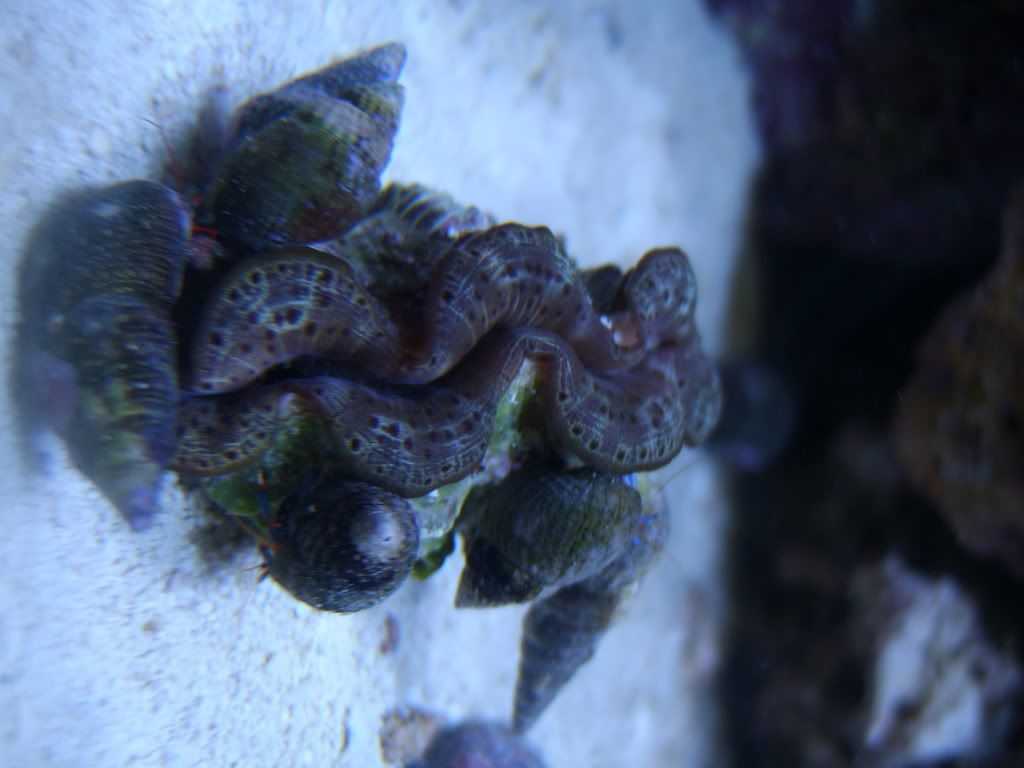 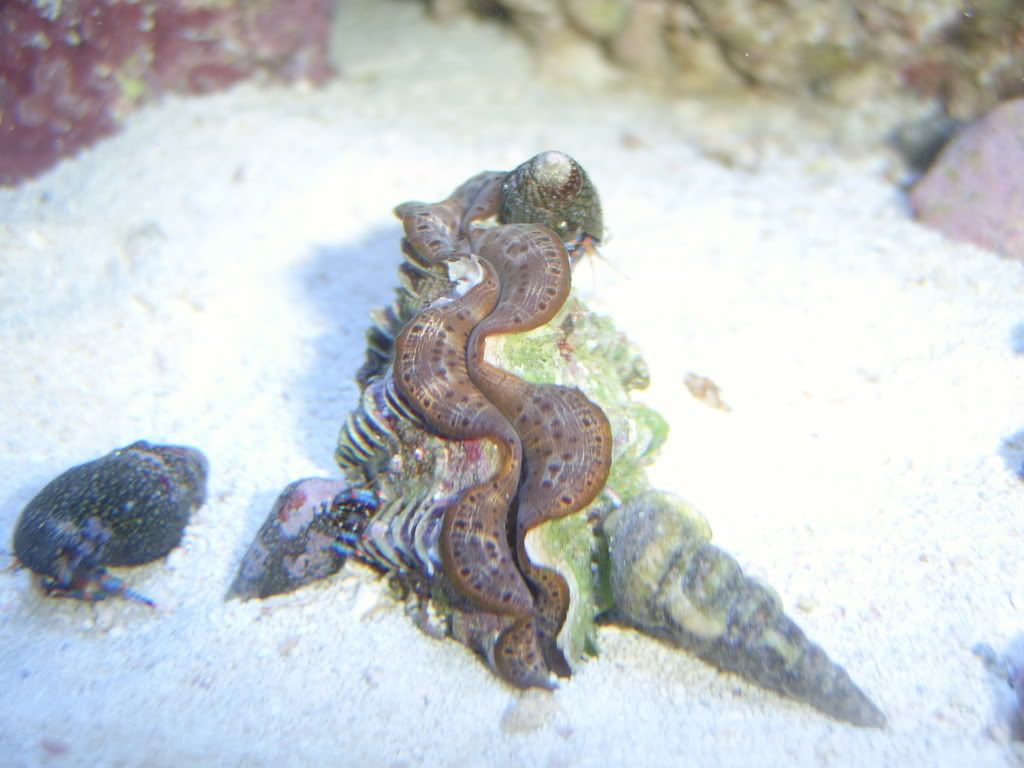 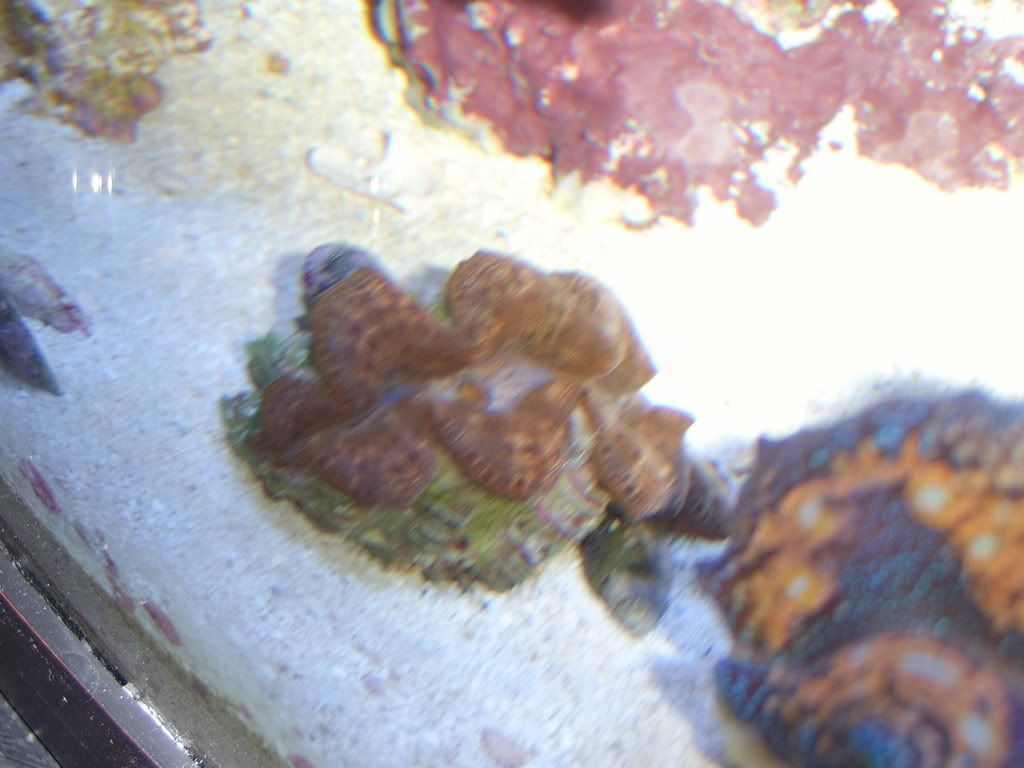 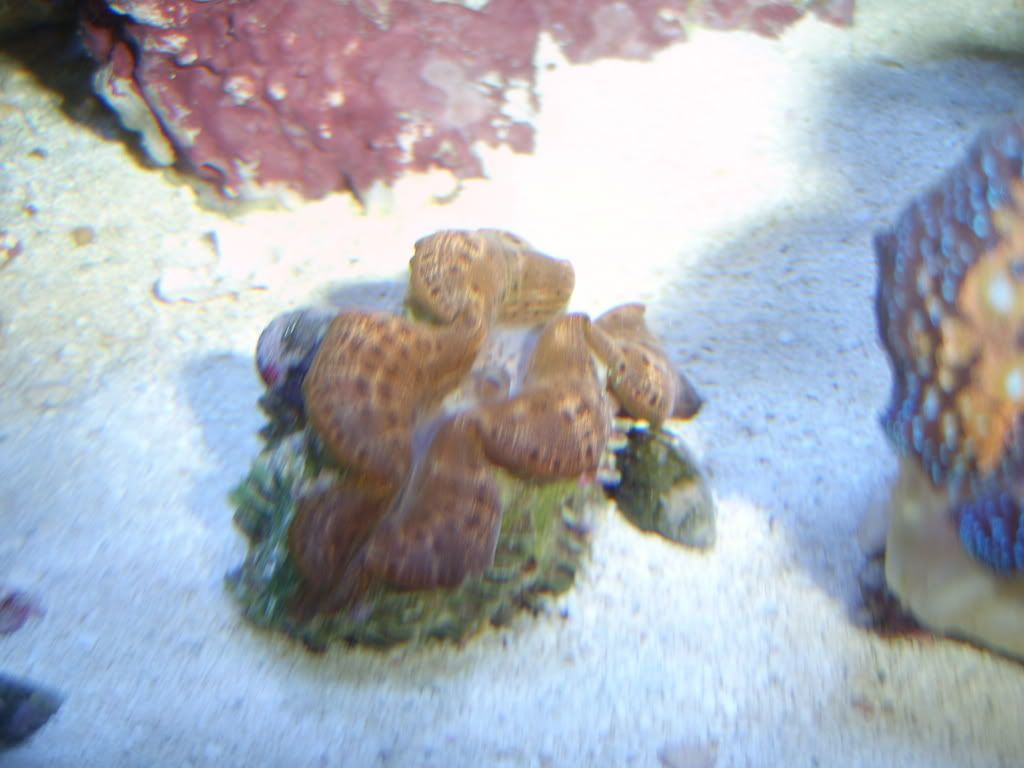
|
|
#17
|
|||
|
|||
|
i think you better get those crabs away from it
__________________
looking for grammar check ------------------------------------------------ |
|
#18
|
|||
|
|||
|
Quote:
__________________
The Original Tang Police Avatar Creator 90 gal sps and mixed other. Tek 6x54 t-5's, DAS EX-1 skimmer, 2x 6045 nano streams. |
|
#19
|
|||
|
|||
|
yes new smells but it would still freek me out
__________________
looking for grammar check ------------------------------------------------ |
|
#20
|
|||
|
|||
|
Bottom line is you can't beat good lighting and..... fish poop!

|
|
#21
|
|||
|
|||
|
they were some feature dusters of some sort on it i chipped away at carefully...that when they run to the clam...they all have moved away now.
Basser what lighting do you recommened. I mean what bulb and K? I have a 250W DE 20k Blueline. Going to get XM's but what K would you recommend? 10k? 15k? 20k? |
|
#22
|
|||
|
|||
|
Updated pic....settling in nice
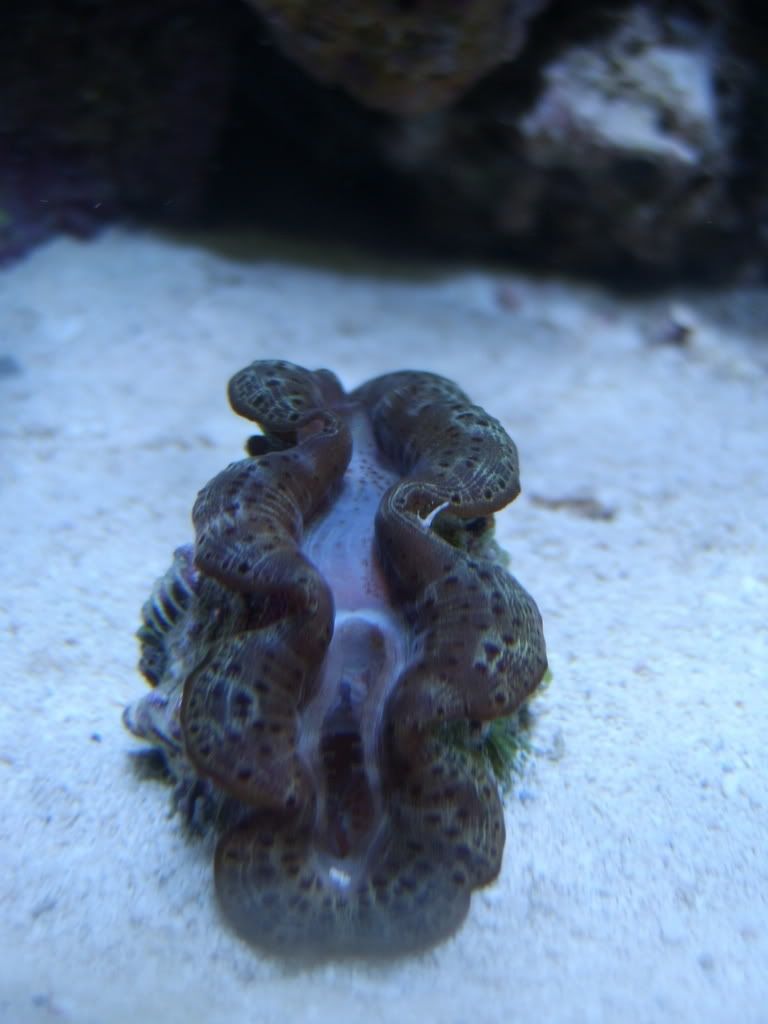
|
|
#23
|
|||
|
|||
|
First of all, I am by no means an expert on clam keeping. There is a sticky on lighting requirements. After reading it, it looks like you should be fine with your set-up.
I have a 3" maxima that I have in my 29 gallon Biocube. For lighting I have 150 watt 14k MH phoenix de bulb, supplemented with 2 - 36 watt 10k actinic bulbs. I've had it now for a little over a month now and already it is showing new growth on the scutes. I do have my clam situated mid-way in my tank and it is placed on a half clam shell on the rocks. |
|
#24
|
|||
|
|||
|
I would take a maxima of the sand bed and place it on a rock. I thought that maxima and crocea needed to be placed on a rock ledge due to there open foot.
__________________
Everything digital has analog parts. |
|
#25
|
|||
|
|||
|
He is being acclimated to the new light
Quote:
|
|
|